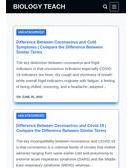Introduction
In this topic, you will learn about the history, classification, merits, demerits, and limitations of the Two Kingdom System of Classification. Classification is defined as the distribution of organisms into groups and subgroups on the basis of similarities and dissimilarities. classification tells us about how organisms are related to each other and how they are different from each other.
The organism which is similar in character is placed in the same group for example sparrows and pigeons both make their nest and lay eggs which are converted into new offspring both have the same character in feeding, their lifestyle to living their nest reproduction method is same so they are placed in the same group. dissimilar character shows that they cant live in the same group so they are placed in a different group.
History
Aristotle starts classification 600 A.E. when Aristotle starts classification there is no proper apparatus or microscope for studying organisms. He just makes classify on the basis of their food-making process. He classifies organism into two groups kingdom Plantae Auto trophes ( Auto means self and trophs means taking food) autotrophs are those organisms which makes their food itself by the process of Photosynthesis or nitrogen fixation.
They are able to make food by combining inorganic compound (Co2 + H2o + light ) to make organic compound Glucose (C6H12O6) .these organisms are almost all types of plants, fungi, algae, cyanobacteria, etc. these organisms put in kingdom Plantae. While the organism which cant prepared their own food are known as Hetrtrophes ( Hetro means other Trophes taking food ) they get their food from autotrophs in the form of leaves grass and meat and placed in kingdom Animilia.these organism include almost all types of animals including human. major types of bacteria some types of fungi etc.
[su_youtube url=”https://youtu.be/5FihKmZtjN4″]
Two Kingdom System of Classification
- Kingdom Plantae
- Kingdom Animalia
1. Kingdom Plantae:
This kingdom includes bacteria(Prokaryotes), photosynthetic plants, and non – photosynthetic fungi. The characteristic features of this kingdom are:
- Plants have branches, asymmetrical body with green leaves.
- Plants are non-motile and fixed in a place.
- During the day time plants more actively involve in photosynthesis than in respiration and hence take more of CO2 and liberate O2 during night O2 is taken in and CO2 is liberated.
- They are autotrophic in their mode of nutrition since they synthesize their own food.
- Plants have growing points that have unlimited growth.
- Excretory system and nervous system are absent.
- Reserve food material is starch.
- Cells have a cell wall. Cells have a lager vacuole.
- Plant cells lack centrosome and they may have inorganic crystals.
- Reproduction takes place with the help of agents such as air, water, and insects. Asexual and vegetative method of reproduction is also not uncommon.
2. Kingdom Animalia
This kingdom includes unicellular protozoans and multi-cellular animals or metazoans. They are characterized by:
- The definite shape of the body and the absence of branches.
- Ability to move from place to place.
- During day and night take in O2 and release CO2 i.e only respiration takes place and there is no photosynthesis.
- Holozoic mode of nutrition since no chlorophylls present and hence they are heterotrophs.
- Growth is limited in animals. Growth stops after attaining a particular size and age.
- The excretory system and nervous system are well developed.
- Reserve food material is glycogen.
- Lacks cell wall. They have small vacuoles.
- Centrosomes are present. Cells do not have inorganic crystals.
- Animals do not depend on any external agents for sexual reproduction.
- Regeneration of body parts and asexual reproduction is found only in lower organisms.
Limitations of Two Kingdom System of Classification
The two-kingdom system of Classification proposed by Aristotle has been in use for a long time. But later it proved to be inadequate and unsatisfactory in view of new information and discoveries about the lower forms of organisms. The following are the shortcomings of the two kingdom system of classification.
- Certain organisms share the characteristics of both plants and animals. eg. Euglena and Sponges. In Euglena, some species have chlorophyll and are autotrophic like plants. However like animals they are dependent on an external supply of vitamins B, and B12 which they cannot synthesize themselves. A few species of Euglena lack chloroplasts and are therefore colorless and non-photosynthetic (heterotrophic). They have a saprotrophic mode of nutrition, carrying out extra-cellular digestion.
Other colorless forms ingest small food particles and carry out intracellular digestion (holozoic nutrition). If green species of Euglena are kept in the darkness they lose their chloroplasts and become colorless and survive saprotrophically. Chloroplasts return when the organisms are returned to the light. Euglena is also characterized by the presence of an animal pigment astaxanthin in the eyespot.
Fungi are a group of organisms that have features of their own. They lack chlorophyll. They are heterotrophic like animals. They are placed along with green plants.
Many primitive organisms such as bacteria did not fit into either category and organisms like slime molds are amoeboid but form fruiting bodies similar to fungi.
The status of viruses whether they are living or non-living is a point of debate even today.


